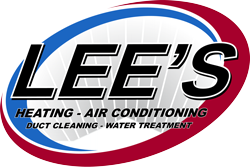There are several important components that play a role in your HVAC system’s operations, and the “brains” of the entire system is your thermostat. There are some situations where thermostats will wear down or have issues that stop them from performing their jobs over the years, however, and you may need to upgrade yours if this is the case.
At Lee’s Heating and Air, we’re happy to assist clients with all their thermostat needs for any of our heating and cooling services, including home automation solutions that involve modern smart thermostats. In many situations, your thermostat (or other parts of your system) will start showing some signs that a replacement is necessary – here are some of the most notable such signs.
Thermostat Can’t Properly Read Temperature
One of the key functions of any thermostat is reading the current temperature of a room or home, then adjusting the HVAC system accordingly. If you find yourself manually adjusting your thermostat to try and get the temperature where you want it, or if it’s just not reacting at all, then this could be a sign that you need to replace your thermostat.
In most cases, this will be due to damage or wear-and-tear to the mechanism itself, but it could also be due to outdated technology no longer keeping up with the demands of your HVAC system.
HVAC System Won’t Stay On
In other cases, you may have begun to notice glitches in your HVAC system, such as the unit shutting off or not turning on at all. If you’ve verified that the system has enough power and is otherwise in good condition, then this could be an indication that your thermostat needs to be replaced – either because it’s malfunctioning due to age or damage, or because it needs an upgrade.
For instance, a faulty thermostat may not be able to properly function within certain temperature ranges, while a smart thermostat may be more responsive and accurate when it comes to regulating your HVAC system.
Changes Don’t Take Effect
In the immediate aftermath of making a thermostat change, such as increasing the temperature a few degrees, you’ll typically notice the system working to meet this demand – such as by turning the furnace on. However, if you’ve begun to notice that despite you putting in commands or settings, the HVAC system isn’t responding, then this could be a sign of trouble with your thermostat.
In many cases, the issue could simply involve a few harsh winters or summers that have caused some damage to the wiring and internal switches, which can all be fixed in a new installation. Alternatively, you may want to consider an upgrade to a smarter thermostat that allows you to take advantage of advanced features and more efficient operation.
Rising Energy Bills (And No Other Explanation)
Another clear sign that your thermostat may need replacing is if you’ve noticed an unexplained spike in your energy bills. If you can’t explain why your HVAC system is using more energy, then this could be a sign of trouble with the thermostat – as it may not be correctly regulating the temperature, or sending inaccurate signals to the rest of your HVAC system. In such cases, you’ll want to discuss the issue with a professional who can help identify the cause and provide an appropriate solution.
Simple Thermostat Age
Finally, while it’s not a “sign” per se, the age of your thermostat can also be a good indicator that you may need to replace it – especially if it’s been in use for more than 10-15 years. In most cases, this is simply due to the fact that technology has improved significantly since then, and you could benefit from an upgrade to enjoy better functionality and energy efficiency.
What to Consider When Replacing a Thermostat
If you’ve decided that now is the time to replace your thermostat, then there are a few factors you’ll need to consider. Firstly, you’ll want to decide whether you want a traditional or smart model – with the former being more basic and cheaper, but also less efficient in terms of energy usage. You may also want to think about features such as remote access, auto-scheduling, and motion sensors for more convenience.
Other than that, you’ll also want to ensure compatibility with your existing HVAC system – which any qualified technician should be able to help with. Finally, consider how you’ll install the new thermostat – particularly if it’s a wired or wireless model. Most commonly, this will involve a few simple steps, though you may want to get a pro in if you’re not sure of how to proceed.
For more on the signs it’s time to replace your thermostat, or to learn about any of our HVAC services, speak to our team at Lee’s Heating and Air today.


